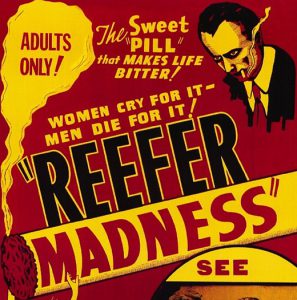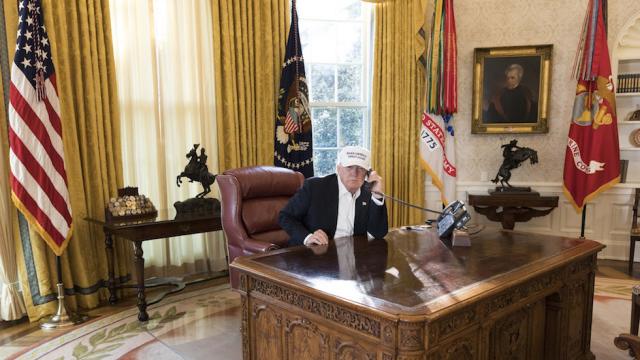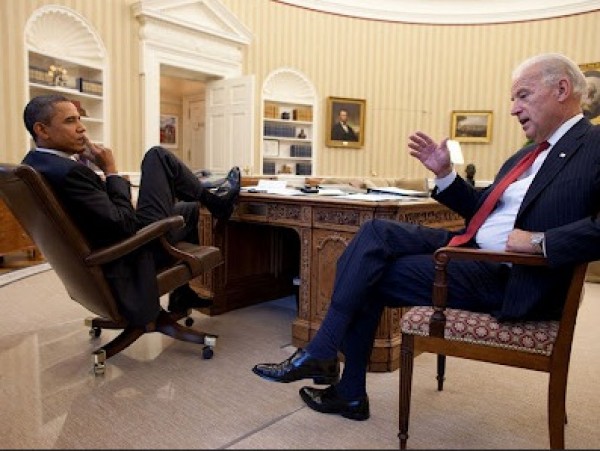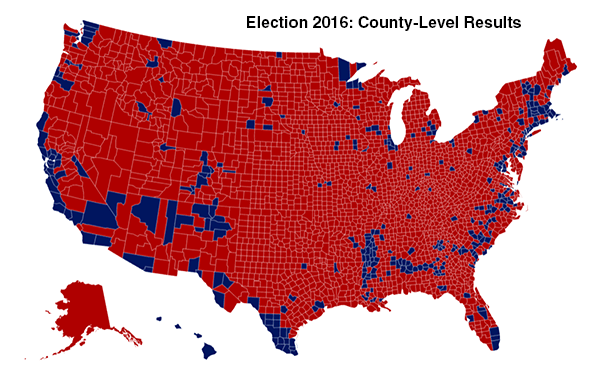Sympathy for the Devil, er, Chuck Schumer
The Senate agreed to a short-term spending bill today, so the shutdown is over, for now, and the can is kicked down the road to February 8.
I’m reading at Vox that today’s bill included six years of funding for the Children’s Health Insurance Program, so if this bill is approved by the House at least one thing will be off the table for awhile. If it doesn’t go through, 1.7 million children in 20 states and the District of Columbia would lose access to healthcare in the next few weeks, and another 2 million children will lose access in just a bit more time. Ten states plus DC would have to shut down their programs in a couple of weeks. It’s being cut pretty close.
However, the bigger concern right now is DACA. I’m seeing lefties on social media absolutely slam Chuck Schumer for caving on DACA. Whether it’s really a cave or just a semi-cave depends on whom you ask.
In agreeing to break the impasse after a three-day shutdown, Democrats are banking that they have successfully pigeonholed Senate Republican leader Mitch McConnell into opening an immigration debate in the coming weeks and that an overwhelmingly bipartisan vote for an immigration bill would put pressure on the House and White House. They are already warning that if their demands aren’t met, another government shutdown could happen on February 8, when the three-week short-term funding bill runs out. And next time they won’t have Republicans dangling a six-year funding extension for the Children’s Health Insurance Program over their heads.
Late Friday night, Democrats drew the line here: our votes will not help fund a government that will deport immigrants brought to the country by their parents as children. Republicans rejected that demand, and the government shut down.
On Monday morning, less than three full days later, they redrew the line at a less-than-ironclad promise from Senate Majority Leader Mitch McConnell to consider legislation in the Senate that would presumably protect at least some of the Dreamer population.
This is unsatisfying in a number of ways, most obviously because the government shutdown will end without any guarantee that Congress, as opposed to just the Senate, will pass, and Donald Trump will sign, legislation that creates permanent protections for Dreamers. To the contrary, the structure of the arrangement almost guarantees that we will reach the next government spending deadline no closer than we are today to resolving the problem Trump created when he terminated the deferred action program for childhood arrivals in September.
There’s no guarantee what Trump might do, no matter what Congress does. He’s already been offered funding for his wall if the Dreamers can be protected, and he shot that down. And don’t forget, Trump created this problem by ending the DACA program, which he could reinstate with a signature. Brian Beutler continues,
Together, the Republican leaders of the House and Senate could take matters into their own hands. It is their cynicism, indifference, and fear, as much as Trump’s incompetence, that leaves Dreamers confronting the imminence of their expulsions.
You know I’m not a big fan of Chuck, but I think he was in a lose/lose situation here. If he’d passed up CHIP funding to hold out for DACA, he’d have been skewered for that, especially if DACA falls through anyway.
Note that a lot of activists were upset with Schumer last week because he offered to fund the wall in exchange for reinstating DACA. Philip Bump wrote at WaPo last week:
When the New York Times first reported it, it seemed unlikely. Senate Minority Leader Charles E. Schumer (D-N.Y.) offered President Trump funding for his wall in exchange for protecting immigrants who entered the country illegally as children? The most powerful Democrat in the Senate was willing to support one of his party’s most-hated proposals, just like that? The Times wrote simply that Schumer “discussed the possibility of fully funding the president’s wall on the southern border with Mexico†— which leaves some wiggle room.
On the floor of the Senate on Saturday, though, Schumer explained that it was almost exactly that: A deal on those covered under the Deferred Action for Childhood Arrivals (DACA) program that would also potentially fund the wall.
That it was. Schumer offered to give Trump something that Schumer’s own base would hate; in return, Republicans would agree to something that their base is fine with.
Yep, that’s what Bump said.
… the DACA program — which allows those who immigrated illegally as children to remain and work in the United States — is broadly popular: 84 percent of Americans think it should be preserved, including 72 percent of Republicans.
 If so, why is it so hard to get a DACA bill through Congress? Two reasons: Trump doesn’t like it, and congressional Republicans are nuttier than a Planters factory.
If so, why is it so hard to get a DACA bill through Congress? Two reasons: Trump doesn’t like it, and congressional Republicans are nuttier than a Planters factory.
Brian Beutler is right that today’s agreement is unsatisfactory, but there’s no guarantee that continuing the shutdown would have created anything satisfactory, either. The zeitgeist I’m seeing on leftie social media today is that Chuck should have let the CHIPS kids die already and focused on DACA, but you know that soon enough people would have noticed the dying children and blamed that on Chuck, too.
Seems to me that if Beutler’s numbers are accurate, it would be in Republicans’ own interest to work with the Democrats on a DACA bill. If Trump vetoes it, that’s on him. But the Republican Party seems to have inflicted on itself the same curse it inflicted on Republican voters — for some reason, they are compelled to vote against their own interests.
It’s also the case that the DACA deadline is not as clear cut as is being made out on social media. Eric Columbus writes in Politico,
So is DACA already dead? Not so fast. On January 9, a federal judge in San Francisco ruled that Trump’s DACA rescission was illegal because it rested on a “flawed legal premise that the agency lacked authority to implement DACA.†The court ordered DHS to resume processing all DACA renewal applications. …
…Most expected that the administration would immediately ask a higher court to put the ruling on hold — in legal terms, to seek a “stay†— pending an appeal.
Instead, on January 13, DHS announced that it would abide by the injunction and reopen the DACA renewal process. Anyone whose DACA permit has expired, or is about to expire, may reapply for a two-year extension. …
…California Attorney General Xavier Becerra, whose state is a plaintiff in the DACA litigation, said that DACA’s temporary reprieve diminishes the need for Democrats to make other immigration-related concessions — possibly including funding for Trump’s wall along the Mexican border, limits on family-based migration, and speeding up the deportation process — in order to save it. Most DACA advocates, however, are loath to let up the pressure for a DACA fix, given the difficulty of finding another suitable must-pass legislative vehicle to force Republicans to the negotiating table.
It’s true that on January 18 the Justice Department asked the Supreme Court to review the federal court decision, rather than go through the court of appeals first, but it’s unlikely the SCOTUS will take the case. However, the Justice Department didn’t ask for a stay of the injunction, which undermines its own case that DACA is a five-alarm fire that must be put out ASAP. Eric Columbus continues,
Either way, March 5 is highly unlikely to mean anything at all. Any end to the injunction—whether at the hands of the Supreme Court or the 9th Circuit—is almost certainly months away at the earliest. And if the injunction is lifted, the administration will need to decide whether to end DACA immediately or develop another gradual wind-down process like the one it announced last fall.
On the other hand, children were in danger of losing health care beginning in a couple of weeks. I think taking the CHIPS offer is a deal I might have taken, too.
I have no feel for whether a DACA bill could pass Congress (although why not, if Philip Bump is right and Republicans like DACA?). I don’t trust that the Republicans will magically start bargaining in good faith. It’s entirely possible that Trump would veto any bill with DACA in it. It’s said he’s being manipulated by the hard liners on his staff, in particular Stephen Miller and John Kelly. Miller is an out-and-out white supremacist neo-Nazi asshole, in spite of being the great grandson of immigrant Polish Jews. CNBC published a story Saturday saying that John Kelly was behind killing a deal to fund the government
Here’s a list of how every Senator voted, if you’re interested.
Trump at Work
The White House released a photo of Trump at work in the Oval Office, at the famous Resolute Desk.
This is Trump working hard to avert the shutdown, the White House says. But what’s odd about this photo? Beside the fact that it’s obviously posed?
I looked for photos of other presidents at the Resolute Desk and found this one:
My, look at all those papers and stuff. But Trump’s desk is empty. Have you ever seen a desk that empty, other than in furniture stores? We can’t see if Trump has someone stashed under his desk, but maybe that’s just as well. I’d rather not know.
Of course, there was also this guy:
Well, okay, Dubya wasn’t the only one who propped his feet on the desk. But there’s other stuff on the desk, too, besides a telephone and a foot.
President Truman had a famous sign on his desk.
Here’s a close up of that sign.
What sign should Trump have on his desk?
Congress: Ignore Trump. Just Pass Something.
The shutdown is Trump’s fault. Make no mistake about that. About the only consistent thing he has done over the past few days is undermine Senate negotiations with his inconsistency.
On January 9, Trump held the famous televised meeting with Republican and Democratic senators that touched on DACA, immigration reform, and funding the wall, among other things. Trump contradicted himself several times during the meeting, but in the end he said he would sign whatever deal Congress could cobble together. “I think my positions are going to be what the people in this room come up with,” Trump said. “If they come to me with things I’m not in love with, I’m going to do it. Because I respect them.”
So on January 11, Democratic Senator Richard Durbin called Trump and said he and Lindsey Graham had a bipartisan agreement. Trump was said to have expressed approval, over the phone. But by the time Graham and Durbin got to the White House later that day, Trump had changed his mind and killed the agreement.
On Wednesday, January 17, Sarah Sanders told the assembled reporters that “we do support the short-term CR” with a six-year extension of the Children’s Health Insurance Program (CHIP).
On Thursday, January 18, Trump tweeted,
CHIP should be part of a long term solution, not a 30 Day, or short term, extension!
— Donald J. Trump (@realDonaldTrump) January 18, 2018
Of this, Dana Milbank wrote,
There was so much head-scratching at the Capitol, they had to bring in a Zamboni to clear all the dandruff.
As The Post reported, Sen. John Thune (S.D.), the chamber’s No. 3 Republican, said he was “at a loss.”
Sen. John Cornyn (Tex.), the No. 2 Republican, chalked it up to presidential confusion: “I don’t know whether it’s clear to the president.”
And Sen. Lindsey O. Graham (R-S.C.) gave voice to the grievance of many: “We don’t have a reliable partner at the White House to negotiate with.” …
…A plaintive Sen. Mitch McConnell (R-Ky.), the majority leader, essentially threw up his hands over immigration talks this week: “I’m looking for something that President Trump supports, and he’s not yet indicated what measure he’s willing to sign. As soon as we figure out what he is for, then I will be convinced that we were not just spinning our wheels.”
I liked this bit:
The New Testament warns: “For if the trumpet give an uncertain sound, who shall prepare himself to the battle?” Trump isn’t playing an uncertain trumpet so much as he is randomly switching between a vuvuzela and a slide whistle.
Yesterday, according to Michael Shear and Maggie Haberman of the New York Times, Trump and Chuck Schumer met for lunch and made a last-ditch attempt to work out a deal.
The negotiations between Mr. Trump and Mr. Schumer, fellow New Yorkers who have known each other for years, began when the president called Mr. Schumer on Friday morning, giving the White House staff almost no heads-up. In a lengthy phone conversation, both men agreed to seek a permanent spending deal rather than the stopgap measure being negotiated by lawmakers on Capitol Hill. …
… As the meal progressed, an outline of an agreement was struck, according to one person familiar with the discussion: Mr. Schumer said yes to higher levels for military spending and discussed the possibility of fully funding the president’s wall on the southern border with Mexico. In exchange, the president agreed to support legalizing young immigrants who were brought to the United States as children.
Mr. Schumer left the White House believing he had persuaded the president to support a short, three to four-day spending extension to finalize an agreement, which would also include disaster funding and health care measures.
I bet you can guess what happened next: Trump changed his mind.
“In my heart, I thought we might have a deal tonight,”. Schumer recalled later on the Senate floor, shortly after the government officially shut downat midnight. At 11:55 p.m., he had been greeted with a blistering White House statement that “Senate Democrats own the Schumer Shutdown.”
What wasn’t happening yesterday were negotiations within the Senate. Jennifer Rubin:
McConnell’s lack of urgency today was stunning. This situation is akin to a labor contract negotiation leading up to a strike deadline. Not to have a single joint meeting with Democrats and the president or exchange any proposals in the final day represents a stunning level of irresponsibility. Republicans control both houses and the White House; not to make every effort to initiate talks and find a solution suggests they no longer know how to cut deals.
Also, too:
Finally, having a self-described dealmaker in the Oval Office was worthless, since the dealmaker is totally incapable of mastering policy details, expressing a policy preference (and sticking with it for more than an hour) and moving both sides to conclusion. This is what comes from electing someone entirely in over his head. It did not help that Trump reportedly whined to staff about missing his party at Mar-a-Lago. His reputation as a man-child remains intact.
The art of the deal? See also He couldn’t negotiate his way out of a paper bag by Digby.
They had more than one bipartisan deal on the table that could have passed both houses. Trump said no. The government is now shut down. Mitch McConnell couldn’t even muster 50 GOP votes much less the addition ten Democrats he needed to break the filibuster. Only essential workers will be working until this is ended. And who knows when that will be?
He didn’t understand the deal and is clearly being led around by the nose by the hardliners. But he also only cares about his base. Maybe it’s time that we recognize and deal with the fact that they want him to deport the DREAMers and ban Muslims and throw black people in jail.
That’s the kind of people they are. He knows this. They want a white America. That’s what this is about.
BTW, five Democrats voted yes last night, and five Republicans voted no. If McConnell had gotten every Republican vote and kept the five Democratic votes, last night’s measure would have passed. So, strictly speaking, it really wasn’t just the Democrats who killed the deal.
I am not aware that there is any constitutional requirement to get the president to agree to a negotiation before it’s voted on in the Senate. The Senate should just ignore Trump and pass something. That something might be nixed by the House, but if it isn’t, then it should be sent to Trump to sign no matter what he says about it. Then, if he vetoes it, he owns it. Indeed, he owns the mess we’re in already as far as I’m concerned.
Doin’ the Shutdown Tango
It appears the government will shut down at midnight, eastern time, barring somebody caving in somewhere. AÂ new Washington Post-ABC News poll says that a substantial majority of Americans will blame Trump and the Republicans if that happens. Republicans are expressing some chagrin about this, but as Josh Marshall points out, shutdowns are part of the GOP brand. And, really, this one would be their fault, too.
From an editorial in the Boston Globe:
Anticipating the public backlash, Trump and some other Republicans are trying to divert blame to the minority Democrats. It’s an odd tactic. It’s true that many Democrats want no part of any deal unless it includes a separate proposal to protect the children of undocumented immigrants from deportation. But the Democrats don’t run Congress.
The real problem seems to be that GOP factions — deficit hawks, military hawks, Tea Party zealots, pro- and anti-immigrant legislators, President Trump’s various personalities — can’t agree on a deal among themselves. The president appeared to endorse a plan to include immigration measures in the bill last week but then reversed himself on Thursday.
The editorial goes on to say that in recent years, McConnell has counted on Democratic votes to pass legislation that the far right members opposed. This seems to have left the impression that Democrats can’t say no.
But now some Republicans, including Trump, are talking about Democratic votes as if it’s something they’re owed. Senator Tom Cotton, an immigration hard-liner, was even demanding “concessions†from the Democrats.
He’s got it all backwards. If the Republicans can’t agree among themselves to a deal — and it looks like they can’t — then Trump and the House and Senate leadership will need to budge, by offering a substantial immigration concession to peel off Democratic votes. Midterm elections are a few months away. If the Republicans want to demonstrate competence, now would be a great time to start.
“If the Republicans want to demonstrate competence, now would be a great time to start.” I’m not holding my breath.
Greg Sargent writes that most of the blame has to go to Donald Trump. His inability to hold on to a firm position for more than ten minutes has left Republicans stumbling in the dark.
I’m told that in a series of meetings between Democratic and GOP leaders and Trump administration officials, Democrats repeatedly pressed their counterparts to make a counter-offer, after Trump rejected the bipartisan deal reached recently that would legalize the dreamers in exchange for some concessions. They have gotten nothing serious in response, I’m told.
Frank Sharry, the executive director of America’s Voice, told me that senior Democratic aides have been privately briefing him and other immigration advocates on these meetings. … “The Democrats keep asking for a counter to the Graham-Durbin bill that would lay out what the White House wants, to see if there’s a middle ground between the proposal on the table and the White House position,†Sharry told me, characterizing the briefings he’s received on these meetings. In response, Sharry said, “there have been no such proposals.â€
Instead, Sharry said, White House officials have continued to circulate documents at these meetings reiterating that Trump wants a number of very hard-line proposals, such as huge sums of money for a border wall and big cuts to legal immigration, which Sharry described as “the Stephen Miller-nativist wish list.â€Â But Democrats continue to ask for proposals that would show what Trump might accept as a middle ground, to no avail.
Is Stephen Miller in charge of White House policy now?
Senate Majority Leader Mitch McConnell (R-Ky.) recently sniped that Trump “has not yet indicated what measure he is willing to sign†and that as a result, lawmakers are “spinning our wheels.â€
It sounds as if even Republicans have given up trying to work out a compromise deal. After the “shithole” meeting, they know they can’t count on Trump to not spit in their faces, never mind Democrat’s faces.
Mitch McConnell needs 60 votes, but he doesn’t even have all of his 50 Republicans. It’s not impossible some Democrats will cave, but I doubt enough of them will.
A Russian-NRA Connection?
This is juicy — McClatchy reports,
The FBI is investigating whether a top Russian banker with ties to the Kremlin illegally funneled money to the National Rifle Association to help Donald Trump win the presidency, two sources familiar with the matter have told McClatchy.
FBI counterintelligence investigators have focused on the activities of Alexander Torshin, the deputy governor of Russia’s central bank who is known for his close relationships with both Russian President Vladimir Putin and the NRA, the sources said.
It is illegal to use foreign money to influence federal elections.
The banker, Alexsandr Torshin, has close ties to Vladimir Putin, and the sort of shady connections one expects from an oligarch in the Putin circle. (He has been charged with money laundering overseas and links to mobsters.) Torshin is also a lifetime member of the NRA, hosted NRA delegations visiting Russia, has attended several NRA conventions, and has spoken with gun enthusiast Donald Trump Jr.
Torshin is not the only link between the NRA and Putin. Last February, Tim Mak profiled Maria Butina, a gun-rights activist who has worked in American right-wing politics. At one Washington party immediately after the election, Butina “brazenly claimed that she had been part of the Trump campaign’s communications with Russia, two individuals who were present said. On other occasions, in one of her graduate classes, she repeated this claim,†Mak reported.
Both Butina and Torshin have also worked with Paul Erickson, a veteran Republican operative and gun rights activist who has cultivated close ties to Russia. Erickson has called the alliance between the NRA and “Right to Bear Arms,†its Russian counterpart, a “moral-support operation both ways.†There is a genuine ideological connection between the right-wing ideology of the NRA and of many Russian nationalists, a strand of violence-obsessed authoritarian pan-European nationalism.
It’s not clear how long this investigation has been going on. Chait continues,
It is also worth contemplating the effect any legal trouble for the NRA would have upon the Republican Congress. There is no more untouchable faction of the Republican Party than the NRA. Already, Trump’s allies have coalesced behind him and used their investigative power to support his wild claims that the FBI is part of a sinister deep-state conspiracy against him. If the NRA is swept up in Robert Mueller’s probe, the pressure on Republicans to fire or hamstring his investigation would ramp up to overwhelming levels.
Something’s got to crack like an egg eventually. If the Republican Party doesn’t crack, it could be the Constitution.
About the Shithole Meeting, and Other News
Here’s what happened, which is a lot worse than the “shithole” comment, per the Washington Post:
When President Trump spoke by phone with Sen. Richard J. Durbin around 10:15 a.m. last Thursday, he expressed pleasure with Durbin’s outline of a bipartisan immigration pact and praised the high-ranking Illinois Democrat’s efforts, according to White House officials and congressional aides.
The president then asked if Sen. Lindsey O. Graham (R-S.C.), his onetime foe turned ally, was on board, which Durbin affirmed. Trump invited the lawmakers to visit with him at noon, the people familiar with the call said.
But when they arrived at the Oval Office, the two senators were surprised to find that Trump was far from ready to finalize the agreement. He was “fired up†and surrounded by hard-line conservatives such as Sen. Tom Cotton (R-Ark.), who seemed confident that the president was now aligned with them, according to one person with knowledge of the meeting.
Trump told the group he wasn’t interested in the terms of the bipartisan deal that Durbin and Graham had been putting together. And as he shrugged off suggestions from Durbin and others, the president called nations from Africa “shithole countries,†denigrated Haiti and grew angry. The meeting was short, tense and often dominated by loud cross-talk and swearing, according to Republicans and Democrats familiar with the meeting.
What seems to have happened is that the anti-immigration hardliners got wind of the bipartisan deal and swarmed to the White House to head it off, which they did.
If we’re getting at least a relatively accurate version of what happened in this meeting it paints a picture of Trump as someone who is easily manipulated and tends to agree with the last person he talked to. Both are facilitated by the fact that he has little real grasp of the issues involved beyond impulsive and racialized knee-jerk reactions. Another key issue in the background is that John Kelly appears to be a pretty hard immigration hardliner all on his own and he’s let Stephen Miller, the alt-righter Trump got from Jeff Sessions, basically run things on the immigration front.
In other news, also in WaPo, the Trump Maladministration plans to ask the Supreme Court to overturn a federal district court injunction that is standing in the way of dismantling DACA.
In other other news, the secretary of Homeland Security revealed today that she doesn’t know DACA from doughnuts.
The secretary of the Department of Homeland Security revealed during an oversight hearing Tuesday that she didn’t know that thousands of DACA recipients had already lost their status as a result of President Donald Trump ending the program on Sept. 5.Â
“No one has lost their status,â€Â DHS Secretary Kirstjen Nielsen said, incorrectly. “No one will lose their status until March 5 or later.†…
…Estimates vary as to how many DACA recipients have so far been left out in the cold: The Hill reported on Jan. 10 that 15,000 people had lost their status since Sept. 5, citing unnamed immigration activists. Sen. Dianne Feinstein used the same number last week. According to the Center for American Progress’ running estimate, 16,166 have lost DACA status between Sept. 5 and Tuesday.
Sen. Mazie Hirono (D-HI) explained the situation to Nielsen, who had earlier claimed incorrectly that only DACA recipients who had been convicted of crimes had lost their status.
See also Here’s exactly how Dick Durbin destroyed Kirstjen Nielsen’s ‘shithole’ explanation at CNN.
In more other news, Steve Bannon testified in front of the House Judiciary Committee today and didn’t say anything. He told the committee that he would not answer questions about anything that happened in the Trump campaign, transition team or White House, because the White House told him not to speak about those things. He appears to be trying to get back into Trump’s good graces. Members of the panel issued subpoenas to compel Bannon’s testimony, the news story says.
However, the big news is that Bannon has been subpoenaed by Bob Mueller. I’m betting Mueller cracks him like an egg.
Jeff’s Reefer Madness
From an editorial in the Decatur (Alabama) Daily:
The U.S. is in the middle of an opioid epidemic.
According to the U.S. Centers for Disease Control and Prevention, from 2014 to 2015, overdose-related deaths from one opioid alone, heroin, increased by 20.6 percent, with nearly 13,000 people dying in 2015.
Meanwhile, there remain no known marijuana overdose deaths, according to the Drug Enforcement Administration, and studies have found states that have legalized marijuana have seen a decrease in opioid-related deaths.
So, of course, U.S. Attorney General Jeff Sessions has decided to ramp up the fight against legal marijuana.
On Thursday, Sessions rescinded the Obama administration’s relatively hands-off policy toward states that have legalized marijuana for either medical or recreational use. Federal prosecutors where marijuana is legal under state law will now be free to decide for themselves how aggressively to enforce federal laws.
 The editorial points to a post at Wonkblog that says SWAT raids of marijuana dealers have caused more deaths than marijuana itself. “Since 2010, At least 20 SWAT raids involving suspected marijuana dealers have turned deadly,” it says. The number of deaths attributed to marijuana overdoses, of course, remains at zero. For all time. Apparently it’s not possible to kill yourself with too much pot.
The editorial points to a post at Wonkblog that says SWAT raids of marijuana dealers have caused more deaths than marijuana itself. “Since 2010, At least 20 SWAT raids involving suspected marijuana dealers have turned deadly,” it says. The number of deaths attributed to marijuana overdoses, of course, remains at zero. For all time. Apparently it’s not possible to kill yourself with too much pot.
But what is Sessions doing about the opioid crisis? Which, according to the New York Times, is “the deadliest drug crisis in American history. Overdoses, fueled by opioids, are the leading cause of death for Americans under 50 years old — killing roughly 64,000 people last year, more than guns or car accidents, and doing so at a pace faster than the H.I.V. epidemic did at its peak.”
Well, pretty much all the stuff the government has been doing all these years that didn’t work. This happened in November:
Attorney General Jeff Sessions on Wednesday announced a variety of measures to deal with the nation’s opioid problem which amount to: Pick ’em up, lock ’em up, throw away the key. He was, in short, reigniting the failed “war on drugs.”
Sessions held a press conference at the Department of Justice focusing on what he called “the worst drug crisis in American history,” offering a plan with about the worst approach to this problem – proven to have failed countless times over the past 100 years.
It gets better.
To add dark comedy to this unfolding tragic drama, we are also told that Kellyanne Conway, the supremely over the top White House adviser and spokesperson, will be put in charge of the varied efforts to control the opioid epidemic. In effect, is she being named the unofficial White House “drug czar,” since none has been officially appointed? Maybe this would seem comic were not 142 Americans dying of overdoses every day, over 60,000 in the past year, which is more than homicides and deaths from motor vehicle accidents combined. Sessions called Conway “exceedingly talented,” for what I do not know.
That was November, though. This happened this week:
In May 2016, Taylor Weyeneth was an undergraduate at St. John’s University in New York, a legal studies student and fraternity member who organized a golf tournament and other events to raise money for veterans and their families.
Less than a year later, at 23, Weyeneth, was a political appointee and rising star at the Office of National Drug Control Policy, the White House office responsible for coordinating the federal government’s multibillion dollar anti-drug initiatives and supporting President Trump’s efforts to curb the opioid epidemic. Weyeneth would soon become deputy chief of staff.
His brief biography offers few clues that he would so quickly assume a leading role in the drug policy office, a job recently occupied by a lawyer and a veteran government official. Weyeneth’s only professional experience after college and before becoming an appointee was working on Trump’s presidential campaign.
In other words, don’t expect to see the opioid crisis to get better anytime soon.
But something else has been nagging at me; this happened in December.
After two years of painstaking investigation, David Schiller and the rest of the Drug Enforcement Administration team he supervised were ready to move on the biggest opioid distribution case in U.S. history.
The team, based out of the DEA’s Denver field division, had been examining the operations of the nation’s largest drug company, McKesson Corp. By 2014, investigators said they could show that the company had failed to report suspicious orders involving millions of highly addictive painkillers sent to drugstores from Sacramento, Calif., to Lakeland, Fla. Some of those went to corrupt pharmacies that supplied drug rings.
The investigators were ready to come down hard on the fifth-largest public corporation in America, according to a joint investigation by The Washington Post and “60 Minutes.â€
And then this happened:
Instead, top attorneys at the DEA and the Justice Department struck a deal earlier this year with the corporation and its powerful lawyers, an agreement that was far more lenient than the field division wanted, according to interviews and internal government documents. Although the agents and investigators said they had plenty of evidence and wanted criminal charges, they were unable to convince the U.S. attorney in Denver that they had enough to bring a case.
In other words, the DEA Denver division was about to bring the hammer down on a dirty company and major opioid distributor, and the Washington DEA Office and Justice Department intervened to let the company off the hook. One suspects some favors were done for somebody. But nobody’s gonna sell any of that marijuana if Jeff Sessions has anything to say about it.
Democrats: Big Tent, Yes, but With Parameters
Here are some things to read about reforming the Democratic Party so that it can grow a broader voter base. However, not everyone is on the same page. And I’ve got my own ideas about who’s right and who’s stuck in old, losing paradigms.
First, let’s review the problem. Here is the 2016 election results map by county:
See the problem? That more people live in the blue spots than in the red doesn’t mean the overwhelming amount of red doesn’t matter, especially if we want to take back Congress. So let’s continue.
Politoco’s Patrick Cavan Brown writes “Heartland Democrats to Washington: You’re Killing Us.” The subhead says that an “elitist” national party is alienating voters. Okay. But the article mostly quotes some good old boys in Indiana who want the Democratic Party to be more about ending abortion rights, being meaner to Muslims and supporting the NRA.
We need to be clear that some things are off the table. Compromising on civil rights — which includes reproductive rights — is off the table. We may not all see eye to eye on what direction to take with gun control, but making guns even easier to get than they are already is off the table. I would not say that an individual Democrat can’t run on right-wing positions, but the positions of the party overall need to be clear on these issues, or the concept of “party” itself has no meaning. The people interviewed speak about a “big tent,” but I say if a tent has no structure at all it’s not a tent.
But what kind of structure will help us turn some of that red back to blue without betraying the constituents who have stuck with us and that we will need in the future?
I say that if a pro-choice Democrat can be elected senator in Alabama, we don’t have to compromise to win elections. Yes, we may lose a few elections on these issues, but we lose more by being squishy. Take stands. Don’t be the generic brand X. We absolutely cannot betray minorities and women and expect to keep their trust. Being squishy has cost Democrats with younger voters also; too many of the young folks just don’t trust the party to do anything for them, and I can’t say I blame them.
Moving on: This article links to a report called “Hope from the Heartland: How Democrats Can Better Serve the Midwest by Bringing Rural, Working Class Wisdom to Washington.” The report was put together by a Congresswoman from Illinois named Cheri Bustos. She interviewed 72 successful Democratic local officials from rural areas in Midwestern states now dominated by Republicans to come up with guidelines for how Democrats can win in the rural Midwest. Her basic advice for what the Democratic Party should do:
- improve its messaging and the Democratic brand;
- focus our policies on jobs and the economy;
- reconnect with voters from the Heartland; and
- adapt campaigns to be more successful in rural areas.
I can’t argue with any of that. The first two items apply to the entire party in every district, in fact.
If you read the whole thing, though, a big fat piece of hypocrisy emerges. These rural politicians complain that the Democrats in 2016 didn’t focus enough on jobs and the economy and instead spent too much time talking about social issues and “identity politics.” But then when you get into what issues they really want to talk about, a lot of them fell back on abortions and guns. At least no one in this report wanted to deny civil rights to Muslims.
Something’s got to give. I say the main focus has to be on economics and bringing opportunity and prosperity back to the rust belt and rural America. The choice is that America can be an economic backwater with discrimination, guns and back-alley abortions, or it can be a 21st-century nation with a strong economy. Period. And I think that will work, because “economic anxiety” is a real thing. Believe it, or not.
Racism Versus Economic Anxiety
American’s lefty hive mind has pretty much dismissed “economic anxiety” as a cause for the debacle of 2016, settling instead on racism/nationalism as the primary if only factor. I don’t think it’s that simple, though.
It’s often pointed out that Trump voters on average had higher incomes than Clinton voters. See? No economic anxiety. But the nerds at FiveThirtyEight did a deeper dive into the data and found something different. Clinton and Democrats generally did much better among nonwhites, who tend to have lower incomes. So, the average income for Democratic voters was lower. But if you control for race, the numbers look different:
Trump significantly outperformed Romney in counties where residents had lower credit scores and in counties where more men have stopped working.2
The list goes on: More subprime loans? More Trump support. More residents receiving disability payments? More Trump support. Lower earnings among full-time workers? More Trump support. “Trump Country,” as my colleague Andrew Flowers described it shortly after the election, isn’t the part of America where people are in the worst financial shape; it’s the part of America where their economic prospects are on the steepest decline.3
From my current perch in rural Missouri, that’s what I see. People here are much more right wing overall than they were in the 1960s. But in the 1960s a young man — yes, we’re talking about young white men — could graduate high school and the next week get a union job working for the local mining company. And there were great training programs available that paid those young men salaries while they learned to be machinists or electricians or whatever kind of skilled worker the mining company needed. So, just about any male who did okay in high school, stayed out of trouble and was willing to do the work could have a steady, stable job that paid union wages and benefits, and thereby pay for a nice middle-class lifestyle. Now, that’s all gone. Other than maybe college — if you can pay for it — there are precious few opportunities for the young folks here that would put them on track for ever enjoying the same standard of living as their grandparents. Even a college degree is no guarantee of anything. There is still money in the community, although from what I can see much of it is in the hands of retirees.
And, of course, you see the same thing all over the rust belt and in many small rural towns throughout America. There have been huge changes since the 1960s, and not for the better.
I’m arguing that in many parts of the country that voted for Trump, the economic anxiety fuels racism and keeps it as alive as if the past 50 years hadn’t happened. Otherwise, a lot of it might have dissipated by now.
David Atkins wrote over a year ago,
Those who argue that economic anxiety fuels Trump’s support do not maintain that voters aren’t racist, but rather that economic anxiety creates the conditions for xenophobic populist animosity. It is no accident that Nazism sprung from the economic horrors of the 1930s, or that neo-fascist groups like Golden Dawn in Greece rose from the terrible economic conditions facing Europe in the age of austerity. The Brexit vote in Great Britain was, indeed, fueled by cultural and racial resentments–but the flames of those resentments were fanned by economic hardship. Conversely, it is also no accident that the greatest civil rights expansions for large minority groups have tended to come during periods of relative economic prosperity, as was the case during the postwar boom of the 1960s. That Trump’s support is strongest in more ethnically homogeneous areas is also no surprise: Social contact with minorities has long been proven to reduce racism, inoculating people against scapegoating by conservative populists.
This is not to say there was no racism in rural Missouri in the 1960s; of course there was. It was blatant. Rural Missouri was just about entirely white in those days and seems very nearly all white now; it remains a stubbornly segregated state. (Frankly, rural Missouri remains mostly white because of the lack of opportunity; there’s little reason to move here, no matter what color you are; there are only reasons to move away.) I’m saying that racism is so entrenched here partly because of the economic anxiety, along with the homogeneity. And Republicans, especially since Nixon, have done a bang-up job feeding the cultural and racial resentments, resulting in the famous tendency of so many poor whites to vote against their own economic interests.
However, for all these years, Democrats have let them get away with that. They have failed to come up with counter-messaging to persuade people that they really would be better off with Democratic economic policies than Republican ones. Indeed, especially since the rise of right-wing radio and Fox News, the only messaging a lot of folks in rural areas hear is right-wing messaging. I’ve been complaining about this for years.
Stop Being Republican Lite
The standard reaction to this problem from the national party is to run “centrist” candidates in conservative areas, which all too often means Blue Dogs who are not noticeably different from Republicans. Seems to me this has had the long-term effect of reinforcing Republican perspectives. It’s buying into their message. I sincerely believe that if over the past two or three decades, Democrats had had the guts to encourage candidates who offered clear alternatives to Republican messaging instead of watered-down versions of it, we wouldn’t be in the mess we are now.
I acknowledge that rural candidates probably don’t want to put gun control and reproductive rights at the center of their campaigns. That’s why Democrats need to be able to speak credibly to working-class folks on economic issues. Unfortunately, they also gave away their old advantage with working class issues. And please don’t read “white” into “working class.”
Stanley Greenberg in The American Prospect:
The Democrats don’t have a “white working-class problem.” They have a “working-class problem,” which progressives have been reluctant to address honestly or boldly. The fact is that Democrats have lost support with all working-class voters across the electorate, including the Rising American Electorate of minorities, unmarried women, and millennials. This decline contributed mightily to the Democrats’ losses in the states and Congress and to the election of Donald Trump.
Greenberg’s piece is worth reading all the way through. Part of the problem, he says, was that the Democratic message of 2016 emphasized the wonderful recovery from the 2008 financial crash. Unfortunately, big chunks of the country haven’t recovered from the 2008 financial crash. Lots of individuals haven’t recovered from the 2008 financial crash. That message just didn’t jibe with people’s experiences. And I realize that much of what Obama wanted to do that would have helped was blocked by Republicans. But at the same time … show me the bankers who went to jail.
Continuing with Greenberg:
The final dynamic distancing Democrats from working-class America is the party’s alignment with the economically and culturally ascendant in America’s metropolitan centers, where Democrats win office and govern. As Clinton’s winning popular vote margin grew to nearly three million, concentrated in an ever-smaller number of urban counties, the Brookings Institution revealed that fewer than 500 Clinton-won counties produced two-thirds of the nation’s GDP in 2015.
Perhaps that is why President Obama and Secretary Clinton sounded so satisfied with the state of America and its future. In nearly every speech for most of his presidency, including in his 2014 State of the Union address, Obama rightly declared that America “is better-positioned for the 21st century than any other nation on Earth.” When he and Clinton closed the 2016 campaign in Philadelphia, Detroit, Miami, Chicago, Raleigh, Cleveland, and Columbus with their upbeat take on America’s future, they symbolically aligned the Democrats nationally with the economically and ascendant cities, and they barely noticed anything amiss in smaller cities and towns and rural America.
This is the plain truth. I keep saying that the 2016 Democratic message was tone deaf to the national mood. That was not the year to exude smug satisfaction, but smug satisfaction was the primary vibe of the Clinton campaign. I realize that there were proposals in the Democratic platform that would have been beneficial to working-class people, but our general election candidate didn’t bother to mention those things in her television ads. So most folks who are not die-hard politics nerds never heard about them. People wanted change. The guy who promised to shake things up sounded more appealing, even to more nonwhite voters than we’d like to admit.
This survey found a significant drop in support for the Democratic Party among black women, for example. Are the Democrats getting anything right?
So, as a great many people keep saying, the Democrats need to clarify bold economic goals and craft a message around those goals that resonates with people, but not compromise on civil rights. And Democrats need to stand with working people, period, instead of trying to please corporations while saving crumbs for working people. Unfortunately, the leadership of the national party is still mostly in the hands of the same people who ran the party into the ground over the years.
I fear we’re not going to get the fresh direction we need until we get new leadership. And that may be too late. In particular I fear the top leaders of the party, who are grotesquely out of touch with younger voters, never mind working class ones, will continue to keep their thumbs on the scale in 2020 when we’re choosing a new presidential nominee instead of letting actual voters decide.
The Young Folks
Finally, I direct you to a document called “Autopsy: The Democratic Party in Crisis” by, um, a bunch of people. It’s got lots of good stuff in it, and I urge reading it. I want to speak to this part in particular —
It’s important to note that young voters are increasingly more left-wing than their counterparts a generation ago — on social and political issues as well as ideology. In addition to their overwhelming embrace of self-described socialist Bernie Sanders, young people are more and more rejecting capitalist politics — with one January 2017 poll showing 43 percent of voters under 30 favorable toward socialism vs. only 26 percent unfavorable. (The generational trend is glaring, with just 23 percent of those 65 or older favorable toward socialism.) In an April poll by Harvard, a majority of young people responded that they do not “support capitalism.”
This generational shift was on stark display during one post-election CNN town hall when an NYU student cited the Harvard poll on millennials’ loss of trust in capitalism and asked Rep. Nancy Pelosi about the party moving left “to a more populist messag” on economic issues. The Minority Leader bolted out of her seat and insisted, “I have to say, we’re capitalists, that’s just the way it is” before letting out a chuckle. The combination of knee-jerk dismissal and “just the way it is” cynicism perfectly distilled the problem the party has selling itself to today’s youth.
At the core of this disconnect is what, at first, appears to be a paradox: young voters are getting more left-wing but also less likely to identify as Democrats. According to a recent Brookings survey, only 37 percent of youth in 2016 identified as Democrats — down from 45 percent in 2008. But the percent who identified as “liberal” in 2016 was 37 percent, up from 32 percent in 2008. So how is it, young voters are moving leftward but identify less with the nominally “left”major party?
And, of course, the Democrats are not a “left” party, not in the same way the Republicans are a “right” party.
With Republicans, you know what you’re getting, like it or not. With Democrats, at least half the time you can vote for a guy who campaigns with noises about fighting for the little guy, and then later we find out he voted to let Payday Loan companies stay in business, or weaken workplace safety rules, or let cheating bankers off the hook, or some such. And that’s been going on for years. We can blame campaign finance laws for that, I guess, but Democrats need to get a clue that all the campaign cash in the world won’t help you if voters just plain don’t trust you.
I’ve quoted Matt Yglesias before —
But though Democrats are certainly the more left-wing of the two parties — the party of labor unions and environment groups and feminist organizations and the civil rights movement — they’re not an ideologically left-wing party in the same way that Republicans are an ideological conservative one. Instead, they behave more like a centrist, interest group brokerage party that seeks to mediate between the claims and concerns of left-wing activists groups and those of important members of the business community — especially industries like finance, Hollywood, and tech that are based in liberal coastal states and whose executives generally espouse a progressive outlook on cultural change.
I’d say the young folks really need and are looking for a genuinely left-wing ideological party, and are frustrated with the Dems that they aren’t.
So, stands on cultural issues have cost Democrats with some voters, but their squishiness on economic issues, especially the problems being caused by what we might call over-reliance on capitalism, is costing them with much of the rest of the voters. The answer is not “centrism” — please — but fresh thinking and clarity on what working-class Americans throughout the nation really need from their government. And then, be champions for that.
The “Autopsy” document also has a section on “War and the Party.” It begins,
The most audible dissent inside the 2016 Democratic National Convention came during the two speeches that most forcefully touted policies of perpetual war. Former Defense Secretary Leon Panetta was taken aback when delegates repeatedly interrupted his primetime address with chants of “No more war.” The next night, just after Gen. John Allen encountered the same chant during the convention’s final session, the Washington Post cited poll numbers that indicated the chanting delegates represented a substantial portion of views among Democrats nationwide.
The wisdom of continual war was far clearer to the party’s standard bearer than it was to people in the U.S. communities bearing the brunt of combat deaths, injuries and psychological traumas. After a decade and a half of nonstop warfare, research data from voting patterns suggest that the Clinton campaign’s hawkish stance was a political detriment in working-class communities hard-hit by American casualties from deployments in Iraq and Afghanistan.
I personally think that a message of not spending trillions on endless military adventures overseas is one that would have broad appeal now. Older Dem leaders are people who came up through the ranks in the years after George McGovern, and the prevailing wisdom then (and, indeed, since the 1950s) was that Dems can’t be seen to be “soft” in foreign policy. We can’t be soft on Communism (hence, the Vietnam War) and we can’t be soft on terrorism (hence, a bunch of Dem senators who should have known better voted for the October 2001 war resolution that got us into Iraq).
In this, and in so many other ways, the 2016 campaign was out of touch. This has got to change.
One More Thing …
The Hill: Lawyer paid $130k to silence adult-film star over sexual encounter with Trump: report. The Wall Street Journal broke the story, looks like.
The Wall Street Journal reported that Michael Cohen, an attorney for the Trump Organization at the time and now Trump’s personal lawyer, arranged for Stephanie Clifford, known in the industry as Stormy Daniels, to receive $130,000 as part of a nondisclosure agreement one month before the 2016 presidential election.
Clifford has privately told sources interviewed by the Journal that she and Trump had a consensual sexual encounter in 2006, the year after he and Melania Trump were married. Clifford was 27 years old at the time of the alleged encounter in Lake Tahoe.
I’m less interested in what went on with Ms. Clifford than I am in how Sarah Sanders is going to dismiss it while insulting reporters for even bringing it up.








